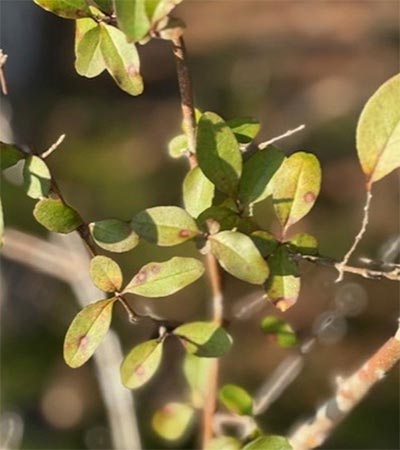The Privet Has Two Faces

Truth be told, accusing Chinese Privet of having only two faces may be underestimating it.
Chinese Privet is at the top of our list for nonnative invasive plants in the Carolina Piedmont region. At quick glance, it’s often difficult to distinguish between the invasive Chinese Privet (Ligustrum sinense) and a few similarly looking native plants – especially since Chinese Privet changes its appearance as it ages and takes on different looks depending on the season.
One would think the Privet’s characteristic properties would make it easy to spot. It’s defined by its brownish grey bark with tiny spotted bumps called lenticels, dark green oval- shaped leaves, clustered white fragrant flowers, and small green berries that turn black in the late fall. Also known for growing in thickets and groves that quickly increase in size due to the multiple suckers that sprout along the roots of the parent tree.

Examples of Chinese privet leaves and lenticels
However, just when you think there’s no mistaking it, along comes the native Eastern Black Walnut (Juglans nigra) and the decorative non-native Crape Myrtle (Lagerstroemia indica) with similar leaf patterns. Eastern Black Walnut produces great tasting nuts and is prized for its high-quality wood used in furniture and flooring. Crape Myrtle, although non-native, is a great decorative landscaping tree, so most people like to have it around.

Left: Eastern Black Walnut, center: Crape Myrtle, right: Chinese Privet

Privet winter appearance
Luckily, in the wintertime the leaves of the Chinese Privet can turn a yellowish green color, as opposed to dropping off – this makes it easy to spot and thus an ideal time to try and kill it.
At certain times of the year, the bark and leaves of the native Sparkleberry (Vaccinium arboreum) plant can feel and look like Chinese Privet. Both have elliptical shaped leaves, flower in late spring to early summer and both produce berries. But they are fundamentally different plants with opposite environmental impacts. This is a tricky one because you certainly would not want to be mistakenly trying to eradicate Sparkleberry. Fortunately, with time it becomes quite easy to distinguish between the two.

Left: Sparkleberry leaves, right: Chinese Privet Leaves
From a distance and at certain times of the year, the native and attractive Possumhaw (Ilext decidua) can sometimes be mistaken for Chinese Privet. Luckily for the Possumhaw, once the berries come out, there’s no confusing the two. And just like the others, once you get used to seeing them all the time, it’s easy to tell them apart.

Left: Possumhaw berries, right: Chinese Privet berries







